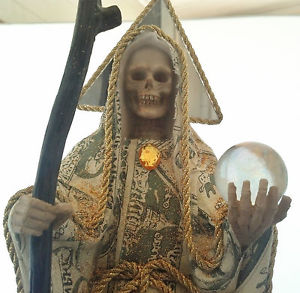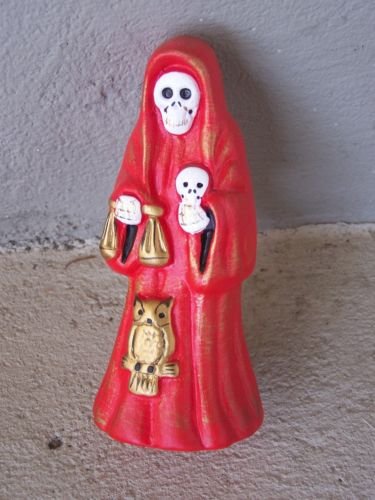Mexico Unexplained: The Santa Muerte, Death Respected
She has many names including La flaca (“the skinny girl”), La hermana blanca or la niña blanca (“the white sister” or “white girl”), La huesuda (“the bony one”), La madrina (“the godmother”) and La niña bonita (“the pretty girl”). Often times she is referred to in the superlative and is called La Santisima Muerte, or “The most holy death.” With tens of millions of followers, the reach of the Santa Muerte extends across the border and the number of her believers has increased in the United States over the years. So who is this hideous-looking saint?

La Santa Muerte – or in English, Saint Death or Holy Death – is personified as a hooded and robed skeleton figure holding a scythe and a globe. She is often holding an old fashioned scale or balance and is sometimes accompanied by an owl. She also may hold an hourglass. Many of her depictions look like an illustration off of a heavy metal band t-shirt, as her imagery closely parallels that of the Grim Reaper. She is dressed in different colors for different occasions and serves multiple purposes. Her veneration is looked down upon by the Catholic Church and has been called “demonic” and “anti-Christian,” yet she is followed by millions, mostly the marginalized, the dispossessed and those who have given up all hope.
Anthropologists have called this type of veneration a “cult of crisis” in that it comes out of times of dire social and economic hardship. As economic times have worsened in Mexico and while violence has intensified, people putting their faith in the skeleton saint has dramatically increased.
No one knows exactly where this saint came from, although the imagery suggests that part of this phenomenon came from the Grim Reaper of European legends. The context – Mexico – suggests that part of the phenomenon came from the Aztec goddess Mictecacehuatl, or “Lady Death,” the ruler of the underworld. Its modern usage and increase in popularity in these times also stem from modern circumstances. The Santa Muerte phenomenon is what the anthropologists call a syncretic belief system, one that blends two or more beliefs to come up with something altogether new.
The reverence for the Santa Muerte began in the 1960s, but its rapid growth has occurred only in the beginnings of the 21st Century when her veneration became less secret and more overt. The main shrine to this folk saint only appeared in 2001 when a woman from the Tepito area of Mexico City named Enriqueta Romero decided to display publicly the 5-foot-tall statue of the Santa Muerte given to her by her son. Now, there are many similar shrines throughout Mexico, but this is the oldest and most attended. Every first of the month there is a special rosary said at the Romero shrine and people bring their statues and Santa Muerte articles to be blessed. As the Santa Muerte is not an officially recognized Catholic saint, she doesn’t have a feast day on the Catholic calendar. Some people celebrate her day on the 15th of August, the 15th of September or November 1. The services performed at the Santa Muerte shrines, including masses and rosaries, are always done by lay people. Behind the Virgin of Guadalupe, the Santa Muerte is the second-most venerated religious icon in Mexico, surpassing St. Jude, the patron saint of the impossible, in the early 2000s.

So, what does the Santa Muerte do and who exactly are her followers? As previously mentioned, she appeals mostly to the marginalized and the dispossessed. People who feel like the Catholic Church has forsaken them have been drawn to this folk saint. This includes the incarcerated, homosexuals, prostitutes, petty criminals, drug dealers and the chronically poor. She has also become the patron of people who work at night and who need protection during the dark hours like taxi drivers, bar workers and so on. She functions much like a regular Catholic saint in that you petition to her for help or give her thanks for favors or miracles granted. As she has wide appeal, the Santa Muerte serves many functions. People pray to her for matters concerning love, health, money, legal issues, and pretty much anything else one can think of. In a major departure from the other Catholic saints, the Santa Muerte is often called upon to work a curse upon an enemy or to exact revenge. Her main function, though, is to provide a smooth transition from this life to the next. Most devotees pray for an “easy death” in the face of an increasingly violent and desperate world. Just as with the Grim Reaper of Europe and the Aztec death goddess Mictecacehuatl, one needs to respect death in order to ensure a pleasant death and this is done by praying, giving offerings, and by lighting candles.
Lighting candles is an important feature of the veneration of the Santa Muerte. Different color candles are lit depending on the different requests of the devotee. Before being lit, the candles must be rubbed all over the person’s body to ensure that the energy and intentions of the devotee are transferred to the candle. Blue is used for healing of the sick and also for wisdom. Green is used for legal problems. Yellow or gold is used for money. White is for giving thanks. Red is for love. Multicolored is for everything. Black is for calming, but it is also used to counteract negative magic, for protection against enemies or to invoke a curse. Offerings left for the saint include cigarettes, alcohol, money and fruit, especially apples. Visitors to shrines often blow cigarette smoke in her face for luck.
The Catholic Church has a problem with the Santa Muerte for various reasons. On his last trip to Mexico, Pope Benedict XVI chastised followers of the Santa Muerte and claimed that the whole phenomenon was a cult. Some say that the Church is upset because it doesn’t have control over the Santa Muerte movement or that it simply doesn’t understand it. The Church however has said that praying to the Santa Muerte is counter to some of the basic teachings of Christianity. Christ came to the Earth to fulfill the promise of eternal life. Death equals sin and therefore praying to Death is in direct opposition to turning to God through Jesus Christ for salvation. Death is a phase of life, not a person, and to have a good death the church says one must have a good life and observe the sacraments. The staunchly religious completely reject the Santa Muerte as the tool of Satan used to trick people into a false devotion. Just in the past 15 years, the Santa Muerte has become one of the most controversial topics in Mexico.
On the American side of the border, unlike other elements of Mexican culture like Day of the Dead and the Virgin of Guadalupe, the Santa Muerte has not generated any sort of cross-cultural appeal with non-Latinos, although some non-devotees may see her image as “cool” or “edgy.” Her devotion is mostly restricted to immigrant populations who are recently arrived from Mexico or Central America. The image of the Santa Muerte is popping up in all corners of ethnic Mexican neighborhoods. In Mexican folk remedy stores called botanicas, found in most major US cities, a great deal of space is afforded to Santa Muerte merchandise with some of the biggest sellers being candles and love potions. The merchandise can range from the artful and the thoughtful to the tacky and bizarre.
People will always looking for some semblance of hope and stability in an often violent and chaotic world. Can one be criticized for one’s faith, even if it is in a skeleton-faced lady who grants curses? Is this just another example of an object of intention having a desired psychological effect or are there larger forces at work here connecting people in a roundabout way to the Divine? As various crises deepen in Mexico, the devotion to this strange looking folk saint will only increase.
http://mexicounexplained.com/the-santa-muerte-death-respected/